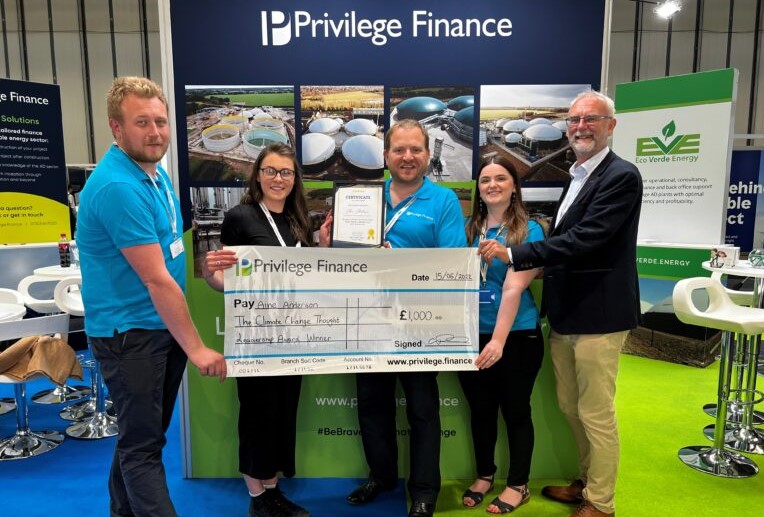PhD student blog - Aine Anderson
Aine Anderson won the Privilege Finance Climate-Change 'Thought Leader' Award 2022, for her research into the potential of anaerobic digestion and agricultural waste to de-carbonise the NI heat sector. Below, she explains more about 'greening' energy

Aine Anderson, second from left, who is carrying out her PhD into de-carbonising the energy sector under the Queen's-AFBI Alliance
According to the Department of Agriculture, Environment and Rural Affairs (DAERA), Northern Ireland (NI) has the potential to produce up to 580 million cubic metres of biomethane annually. Recent analysis of feedstock mapping supports even higher biomethane potential values from manure and underutilised silage material in NI.
This amount of biomethane, which is a green gas produced by anaerobic digestion (AD), could generate over 2,000 GWh of heat every year[1]. Although used commonly in NI for the purpose of electrification, AD isn’t currently used to produce biomethane for the gas network– a sustainable replacement for natural gas. However, there is huge potential for AD to have an impact on the decarbonisation of the NI gas grid.
Until this year, injection of biomethane into the gas grid was prohibited and there was no incentive for farmers, nor gas companies, to decarbonise the heat sector. A large number of homes in NI still rely on oil for heating and therefore a huge infrastructure change would be required. Alongside this, electrification is commonly used throughout the country which could have an effect on the demand for green gas. However, legislation has now changed which provides an opportunity for decarbonisation, providing NI has enough organic material to meet the gas demands.
As part of my PhD, I completed a research project looking at the potential of AD to decarbonise the heat sector in NI. There’s a real need in NI to map the potential for creating a more renewable gas for the purpose of heating. Maps which I had previously created looking at the manure and silage production from NI agriculture, doubled up as feedstock mapping for AD production. I used these to understand what needs to be done to kickstart heat decarbonisation in NI.
Manure management in NI
NI has a dense livestock sector, producing large amounts of manure. The majority of this is spread across land as an organic fertiliser but the risk of nutrient overloading is high.
To overcome the over-application of organic nutrients in some areas and reduce the risk of runoff to rivers or accumulation in the soil, manure needs to be processed and redistributed. This is an issue which NI needs to deal with, independent of the heat decarbonisation issue.
AD can recycle manure to create biogas, a source of renewable energy, and digestate, an organic fertiliser. However, we need to sustainably manage the processing and redistribution of digestate material, to better support nutrient management in NI.
NI’s heavily populated livestock regions, coupled with a need to decarbonise the heat sector, led me to research the scope for using anaerobic digestion as a means of processing livestock waste to produce green gas.
Understanding the demand for biomethane
During my research I observed the demand for gas within NI and calculated how much biomethane we can generate from organic material. From this I could understand whether there would be enough organic material available if the government was to incentivise it.
I also considered the positioning of the AD plants, as decarbonising the gas grid would require new infrastructure. This is because the current AD plants already receive an incentive to generate electricity until late 2030s so there isn’t scope for these plants to produce biomethane at the moment.
Mapping using geographic information systems
You can work a lot out using mapping systems. Mapping allows for the collation and creation of data sets to understand the availability of feedstock in a specific area, along with the demand for gas. This can ultimately help determine the number of AD plants required to process the feedstock to meet the gas demand levels.
By using the NI heat distribution grid, I collected data on the gas demand across 15 different areas of NI. Then, by drawing 10km boundaries from the various gas grid injection points, I could quantify how much manure material and underutilised silage was within that section and used this data to determine the percentage that you could decarbonise each area by.
This collection of data enabled us to see which areas should already be using AD as a means of heat decarbonisation, but also highlighted areas where exportation may be required. For example, agriculture is low in Belfast, but the city has a high gas demand. However, agriculture is much more dense in areas surrounding Belfast and the gas demand is relatively lower, so redistribution of excess gas to areas like Belfast would be possible.
Research method
I worked alongside gas companies and DAERA to collect data, which I could input into layer building software. High resolution farm data sets provided me with precise information on farm animal numbers and grass area, allowing me to map out the potential feedstock availability in different areas.
Literature reviews of other studies looking at heat decarbonisation other countries including England and Denmark showcased the possibilities for AD, and the different ways to incentivise a scheme such as this.
A huge blocker to heat decarbonisation in NI is the lack of an incentive. Until government bodies know how to incentivise this for farmers and those with available organic materials, the process runs the risk of sitting stagnant.
I am continuing to investigate the scope for AD and agricultural waste as a means of decarbonising the heat sector, and I feel it’s definitely an opportunity which NI must take. My research has also highlighted other aspects that biogas can be used for, including transport, demonstrating that there is huge potential and future for this renewable energy source across many sectors, not just heat.

